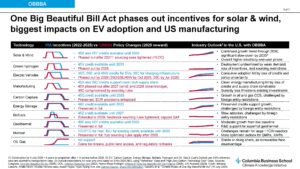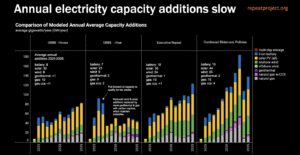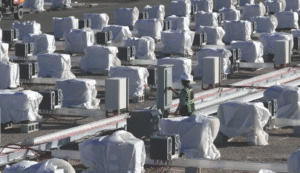Blink Twice if you are Endangered
So that One Big Beautiful Bill Act passed, as I am sure you have seen. Other folks have much better summaries than I would provide such as this Columbia Business School analysis (which is where the graphic below comes from) and from Latitude Media Heatmap News. TL;DR – higher costs, fewer renewables built (although likely to still dominate new generation), slower EV adoption.
 Credit: Columbia Business School
Credit: Columbia Business School
 Credit: Repeat Project
Credit: Repeat Project
Quickly following this legislation, the administration also directed the Treasury to examine and update the eligibility criteria of the tax credits that are sunsetting, to further weaken and create uncertainty with them (this was a legislative demand that wasn’t able to be included in the bill itself because it lacked the support).
Overall, I definitely underestimated the desire to damage the renewables industry (beyond just making them less competitive with existing fossil assets), as the wind and solar tax credits had been around for a couple of decades but were wound down, even as oil and gas tax subsidies were expanded.
Meanwhile, Trump’s EPA is trying to reverse its endangerment finding, which undergirds the regulation of carbon emissions. This will play out over a number of years in the courts, but depending on how it shakes out, could be a bump in the road, or could permanently prevent the EPA from regulating greenhouse gas emissions. On the other hand, this approach has the potential to also open up a potential pathway for states to regulate these emissions on their own in the future (by the constitution states are pre-empted by federal government activity, but can pass laws on stuff the federal government is not legislating on). Politics is sometimes described as iterative cycles of over-reaction and overreach – this move seems like a great example of this idea in practice!
Raise Your Hand If You Like Flexible Loads
An emerging space is the intersection of energy efficiency and AI. Specifically, how to manage and adjust the large loads of AI data centers so they are can avoid peak operational periods, which can save money and reduce emissions. Nvidia and Oracle worked with one such startup in this space, Emerald AI, to reduce load by 25% during peak periods without impacting the quality of the computing work. This has huge potential, since we’re both going to be using a lot more energy for computing over time, and because the grid has plenty of extra capacity most of the time (often at lower carbon intensities as well).
More importantly, it can also open up new approaches to interconnection, where new large data center loads can connect to the grid more quickly and at lower cost (avoiding some distribution system upgrades) by agreeing that their loads can be curtailed during peak periods. The Southwest Power Pool system operator now has a process in place for this and other grid operators are exploring it as well. While data centers are heterogeneous and not all of them have highly flexible loads, there’s still an enormous opportunity here (and we may find that the startups innovating in this space help a larger share of previously inflexible loads become more flexible). I am confident that this will not be the last time we talk about load flexibility in the cleantech roundup.
Behold, the Electric Vehicle Life Cycle is Evolving
While the IRA EV tax credits were in place, a significant share of new EVs were leases (because of idiosyncrasies in the Treasury guidance). As a result, even as the OBBBA eliminates EV tax credits, there are going to be a whole bunch of relatively affordable EVs coming to the market in the next couple of years, in the form of lightly used cars that are sold after their three-year lease period is up.
 Credit: Redwood Materials
Credit: Redwood Materials
On the other end of the life cycle, battery materials recycler Redwood Materials shared that they deployed a second life battery grid storage system, which is a technology approach that to date is often discussed but not frequently implemented. One interesting wrinkle here that contributes to the economic value proposition is that this is not intended as a long term deployment, but rather another stop on their way to being recycled. So instead of choosing whether to reuse or recycle them, they are doing both – sticking them on the grid for a while, to extract their useful capacity (in a use case that is less intense than a car accelerating) and then transition them on to be recycled (see above for the very temporary looking deployment, with batteries wrapped on plastic up on cinder blocks.
Other News
 Credit: Google
Credit: Google
Google signed a new deal with long duration storage company Energy Dome. In Google’s announcement, they also highlighted how they are working to advance policy and market rules for energy markets to fully value firm, flexible carbon-free technologies, which is very much in line with what Evergreen needs to happen to enable long duration storage at scale.
In Norway, the first shipping terminal for CO2 storage recently opened in the north sea. This Northern Lights project is jointly owned by European oil majors TotalEnergies, Equinor and Shell; it is being referred to as a “carbon dump” or a “garbage disposal for emissions.”
The Department of Energy cancelled the loan guarantee for the Grain Belt Express transmission line (which we’ve talked about several times). This is an effective way to undermine the credibility of the government and efficacy of large programs long term and the exact opposite of what we actually need in terms of support for transmission.
Stellantis stopped their hydrogen fuel cell technology development program. Hydrogen fuel cell vehicles had been under development for decades but were rapidly eclipsed by electric vehicles (fun fact – if you asked automakers 15 years ago what they thought the future was, just as electric vehicles were coming out, they thought it was still hydrogen fuel cells and that EVs were just going to be for regulatory compliance and early adopters).
A couple of new organizations recently announced their existing – first of a kind project ecosystem supporter Node Climate and climate convening platform Constructive. These are things that the U.S. Department of Energy theoretically could be doing, and in some cases, was actually doing previously, but is not currently.
Electricity prices will continue to rise after the most recent PJM auction, where capacity prices are up 22%. Although no one wants higher prices, higher capacity prices are at least in theory a good thing because they serve as a signal to build new generation; unfortunately, in PJM the interconnection process is pretty broken, so for the most part the folks that want to build new generation have already been waiting a long time to do so. So, this signal is a little muddier than it would ideally be.
Even though federal funding has ground to a halt for EV charging infrastructure, fast charging stations are actually growing significantly as a function of newer charging network players in the space like Mercedes-Benz and Walmart.